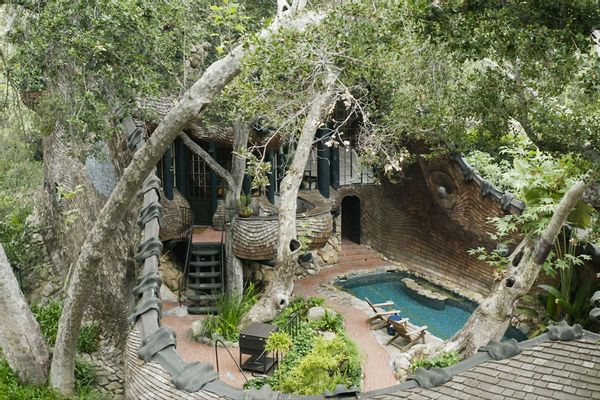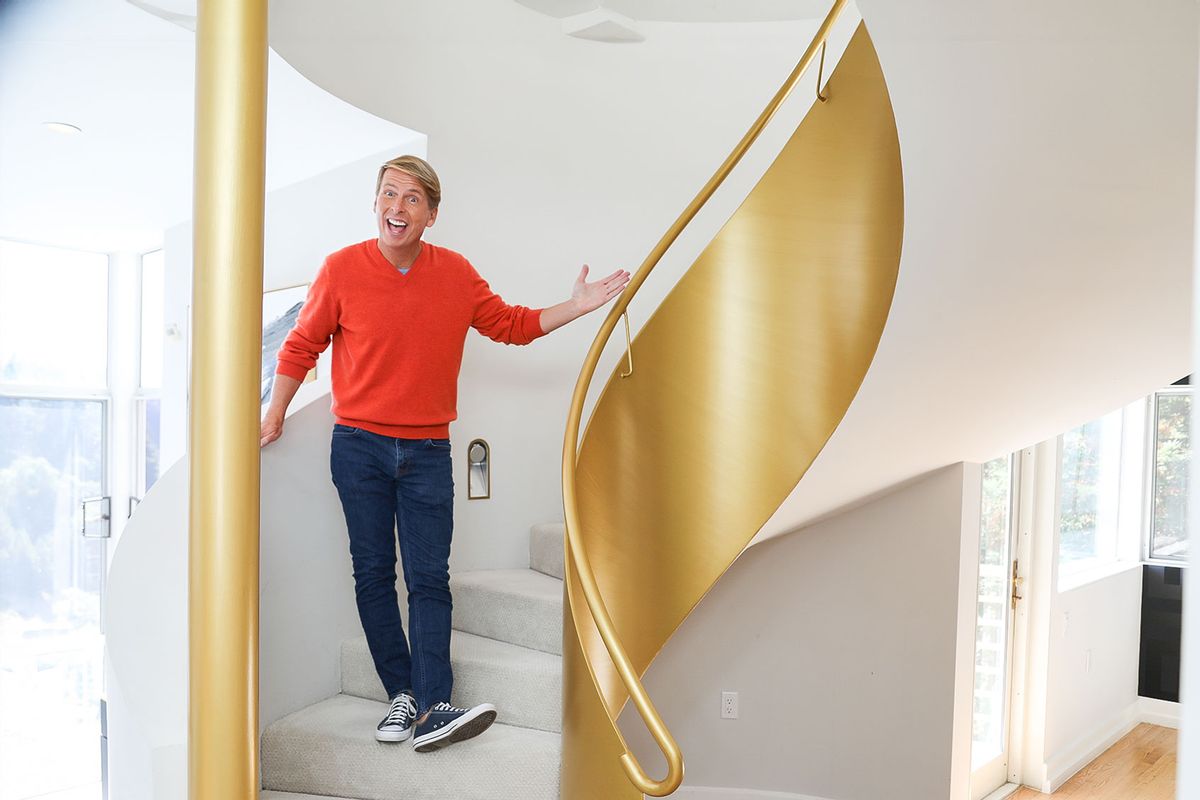What closed the “Zillow Gone Wild” sale for me was its X account’s 2022 listing of a four-bedroom, three-bathroom Onalaska, Wis., home. The cozy ranch greets you with a 1970s brown brick exterior and monochromatic Millennial grey décor, accessorized with homey mall-acquired comforts.
A throw pillow that reads “Our Nest” rests on a side table. Hanging on the kitchen wall is a decorative cutting board commanding us to “EAT” in block letters.
The pièce de résistance that made the feature go viral, however, is the framed sign above the main bedroom’s headboard that reads, “Welcome to Poundtown.”
“Zillow Gone Wild” creator Samir Mezrahi gamely characterizes the home’s staging as “a good example of what happens when your Michael’s obsession goes one sign too far,” a line that punches up a standard slideshow to a visual gag worthy of “Curb Your Enthusiasm.” (Can you even imagine?)
Had it been offered up two years later, “Poundtown” might not have made the cut. The pop culture value of “Zillow Gone Wild,” like most closely watched Zestimates, has skyrocketed – and not only because HGTV adapted it into a series hosted by “30 Rock” star Jack McBrayer.
“Zillow Gone Wild” and Zillow, broadly, are examples of the ways an Internet-based service designed for a commercial purpose ends up doubling as entertainment. Zillow doesn’t lack competition in the online real estate promotion business, but 18 years after it launched, it is a mood, a show, a soothing time waster, porn without the NSFW bits.
Also around 2006, HGTV was ascendent on basic cable; in 2007 its hit “Design Star” drew a larger audience than “Top Chef.” In 2024, with Zillow being the internet’s version of “House Hunters,” the network is responding to be more like Zillow.
On the TV edition of “Zillow Gone Wild” eccentric design is not in itself enough to sustain the premise; the network already has several programming gewgaws celebrating opulent tackiness in home decor and overhauling interior design disasters.
The pop culture value of “Zillow Gone Wild” like has skyrocketed – and not only because HGTV adapted it into a series.
Besides, as anybody who has wasted precious time on either the Instagram account or its X counterpart knows, reading the comments is most of the fun . . . along with the scrolling, of course.
The TV show approximates that experience by imitating a March-madness bracket, pitting each week’s “wild” home against the others, and challenging viewers to correctly guess which one ultimately wins the honor of “Wildest House.”
Zillow Gone Wild (HGTV)The Retta-hosted “Ugliest House in America” has run on a nearly identical formula for five seasons, although the ultimate prize sounds nicer on “Zillow Gone Wild,” offering a $25,000 pot to one viewer who correctly guesses the winning house. Still, “Ugliest House” also owes a debt to Zillow for the way it accelerated the gamification of online real estate shopping.
With homeownership increasingly out of reach for the average middle-class worker, Zillow is as much of an aspirational diversion as it is a real estate sales tool. It’s popular among homeowners, people ready to move and permanent window shoppers, enjoying 217 million average monthly unique users and 2.3 billion total visits over the first quarter of 2024, it revealed in its recent earnings report.
Surely entertainment analysts would take issue with efforts to compare its performance to cable and streaming content. They are different industries of course . . . unless one factors in the crossovers, and we’re not just referring to the many Barbiecore contenders on “Zillow Gone Wild.”
In some ways, Zillow is better than TV. It doesn’t require special equipment or a subscription. All you need is a phone.
The fictional “Glass Onion” compound featured in the “Knives Out” sequel enjoyed a listing for a time. More recently in the wake of Disney+ “Bluey” breaking our hearts with its 30-minute episode “The Sign,” Zillow hired Ryan Reynolds’ agency Maximum Effort to produce “A Moving Commercial,” using actual blue heelers to soothe parents into the idea that selling a home doesn’t need to traumatic.
But Zillow has been aware of its pull on Millennials and Gen Z for some time, proven by the Pop-Tarts listing of a 35-square-foot house in November 2022. Back then teens and 20-somethings hadn’t yet made Zillow surfing video reactions its own TikTok fad. That’s a thing now, especially late at night.
We get it. In some ways, Zillow is better than TV. It doesn’t require special equipment or a subscription. All you need is a phone. Where shows thrive or fizzle based on whether we enthusiastically welcome their characters into our living rooms, Zillow does the opposite, allowing us access to the lives and physical spaces of other people. The very online can not only tour the inside of their neighbors’ houses without their awareness or permission, but they can see how much they paid and view tax data. They can also covet or be judgy.
They can also dream, lust (the joke driving that 2021 “Saturday Night Live” skit with Dan Levy) and maybe set goals. Living in a big city is expensive and cramped, but if you’re willing to commute, and possibly live in a missile silo, a person might finetune their career blueprints to make that happen.
 Zillow Gone Wild (HGTV)“Zillow Gone Wild” boasts 1.9 million Instagram followers today and 619,000 followers on X, an audience that grew rapidly owing to the account’s launch in December 2020 during the first and darkest winter of the COVID pandemic. Its opening act captured the angst of lockdown cabin fever with a famous Vermont listing that rolls out a series of very average-looking interiors before revealing the domicile’s quirkiest feature: rusty jail cells with rotting commodes.
Zillow Gone Wild (HGTV)“Zillow Gone Wild” boasts 1.9 million Instagram followers today and 619,000 followers on X, an audience that grew rapidly owing to the account’s launch in December 2020 during the first and darkest winter of the COVID pandemic. Its opening act captured the angst of lockdown cabin fever with a famous Vermont listing that rolls out a series of very average-looking interiors before revealing the domicile’s quirkiest feature: rusty jail cells with rotting commodes.
Many such jail houses have turned up on Zillow and its social feeds since, although more recently “Zillow Gone Wild” Instagram selections have tended to feature the uncommon and the baroque, the ridiculously expensive and the sublimely affordable.
Want a daily wrap-up of all the news and commentary Salon has to offer? Subscribe to our morning newsletter, Crash Course.
Whether a home comes with acreage or is tiny but somehow unique, it’s both a real estate agent’s tool and a showcase of over-the-top creativity, like the colorfully painted but unassuming Las Vegas home that hides a pirate ship-themed interior that extensively commits to the mood.
The pirate house made its Instagram debut last July as part of Mezrahi’s “You Never Know What’s Going On Inside a Home” theme on the account, and turns up on the show in an early episode. It’s one of an array of homes with some “wackadoo” feature or another as part of their owners committing to a bit, with the difference being the human element.
 Zillow Gone Wild (HGTV)
Zillow Gone Wild (HGTV)
McBrayer exuberantly roams these places with their owners or a listing agent expressing wonder as he turns every corner, never making fun of the decor regardless of how garish or nonsensical they may be.
He reminds us that these “wild” places sprung from the imaginations of creative individuals – real people attached to spaces they loved as opposed to unseen entities removed from the room. The space is the star regardless of how one prefers to tour “Zillow Gone Wild”; most will likely favor the host-free voyeuristic route Instagram and X afford.
But if you prefer the personal touch by way of a guided tour, McBrayer has your invitation.
Read more
about this topic
